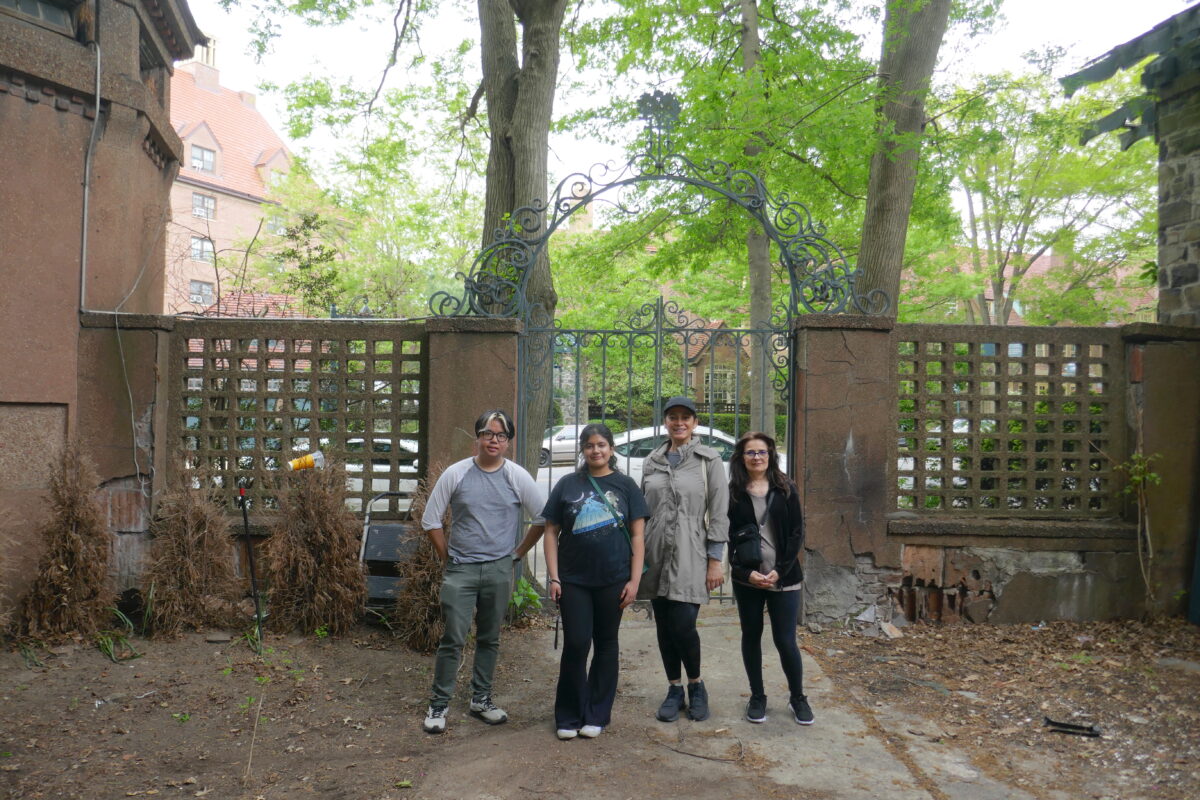Ceremony Sparks Dialogue for Tea Garden’s Rebirth
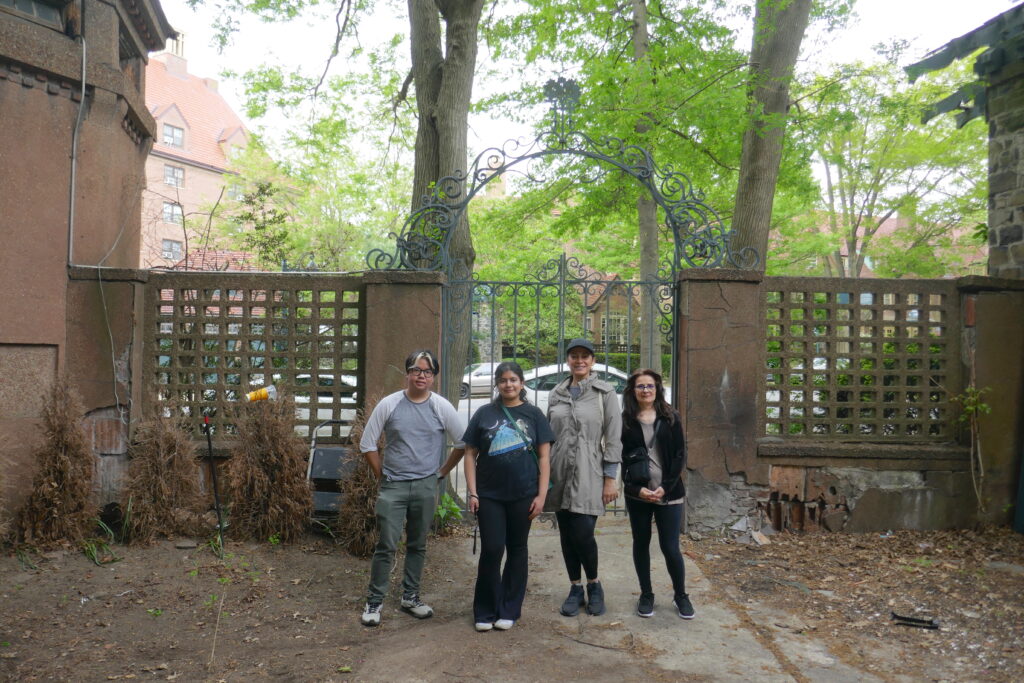
Attendees in front of the historic gate bearing Forest Hills logo. Photo: Michael Perlman
By Michael Perlman | mperlman@queensledger.com
Behind an ornate gate on Greenway Terrace and under an over century-old Gothic archway-inspired tree canopy lies the Tea Garden, which opened in 1912 as part of the iconic Forest Hills Inn. Today, Jade Eatery & Lounge’s party room in Forest Hills Gardens leads to this historic yet long-forgotten Tudor-style retreat, awaiting further restoration and revitalization.
On May 7 at 4 PM, a traditional “Tea Time” gathering took center stage in the Tea Garden, where a very engaged assemblage of members of the New York Tea Society (NYTS) met local residents. They made friends while exploring the art of drinking tea, shared tea stories and site history, and envisioned the garden’s beautification and future capabilities.
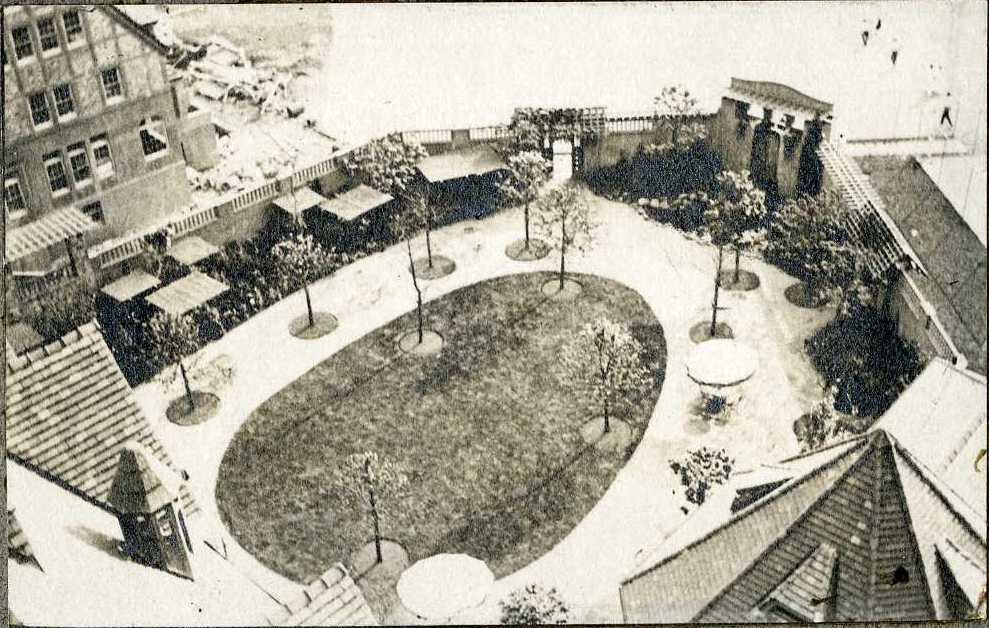
Tea Garden circa 1912. Photo courtesy of Olmsted Archives.
“We want to bring our history back,” said Kumar, the owner of Jade Eatery, who treats patrons like an extended family and shared over an hour of quality time with ceremonial guests. “Everyone is very much excited, and I am so honored to be part of the Tea Garden. The tea society brought along great flavored tea that was nice and hot, and they gave us a great presentation.” Kumar plans to partner with the organization and serve a variety of carefully selected teas.
Tea is the second most consumed drink worldwide. NYTS, which operates out of a Forest Hills tea studio and holds gatherings on weekends and digitally taps into an international fanbase, is on a mission to “facilitate the gathering of tea enthusiasts to promote tastings, discussions and education about tea and tea culture.”
Roy Lamberty, founder and president of NYTS and a director of food and beverage of Marriott Hotels, served a Taiwanese High Mountain Oolong known as Dayuling. “It is a very floral and bright tea, perfect for a spring day. Meeting other Forest Hills neighbors and introducing a Chinese gongfu tea service is our passion at NYTS. If I could do it every day, I would, and I loved meeting everyone,” he said.
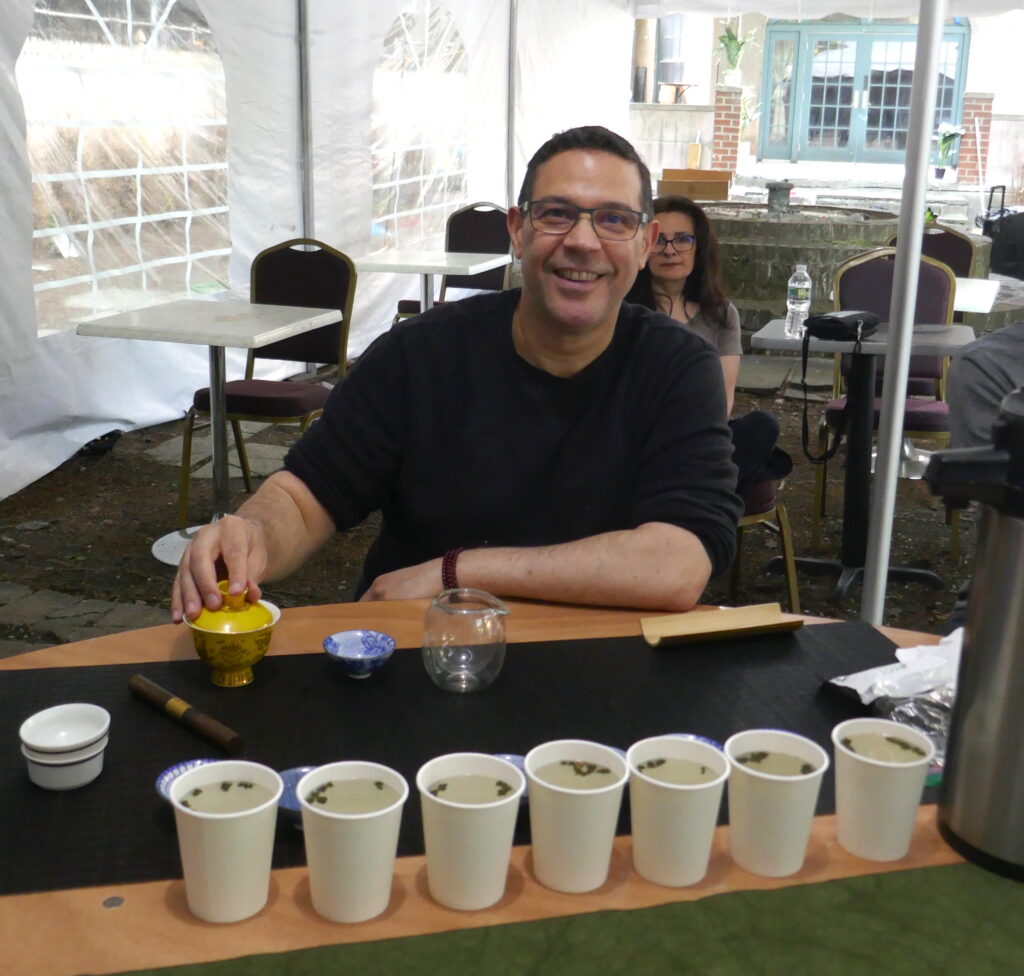
Roy Lamberty, New York Tea Society President. Photo by Michael Perlman
Authenticity conveys value. A gaiwan was used and small traditional three-sip cups. “High Mountain Oolong is a tea that holds all of its original nutrients that are within the semi-oxidized tea. It contains hints of chestnut flavor paired with a nutty aroma,” said Forest Hills resident David Edelman, a very active NYTS member since 2020. He is a social studies teacher at Union Square Academy for Health Sciences in Manhattan, who takes his passion a step further by operating a tea club.
Eyeing the future, Lamberty envisions Indian, English, and Chinese tea sessions coexisting, pending Kumar’s approval. “It would be filled with historical and mythological stories, which would amaze guests,” he said.
As for Edelman, he explained, “The NYTS would love to host future tea gatherings in the historic Tea Garden to introduce more people to tea culture, and experience the simple enjoyment of thoughtfully preparing and drinking tea with new friends.”
Edelman imagines spending an afternoon in the garden, ringing the tea bell to order cup after cup. “Ringing the bell helps one to connect with the neighborhood’s allure and hidden history. The Tea Garden is a little gem, hidden within the larger treasure of Forest Hills Gardens.”
He overheard commentary from attendees who discussed a need for local routine historical walking tours. “I could visualize the Tea Garden being the meeting place for such events, as well as a community space to recreate and celebrate local history. One can easily envision music, magic, theater, dance, all within this space.”
The tea gathering continued along the path of restoration, since on March 31, preservationists were first to witness the delivery of a highly stylized “Ring For Tea” stand, after the original vanished approximately 75 years ago. Attendees also rang its circa 1890s bell and drank tea. The replication was made possible through tours and puzzle sales by this columnist, in partnership with volunteer civil engineer Bea Hunt, Flushing Iron Weld and Noble Signs.
The Tea Garden was designed by Forest Hills Gardens principal architect Grosvenor Atterbury and landscape architect Frederick Law Olmsted, Jr. It once accommodated Forest Hills Inn guests and their friends with afternoon teas, dinner dances, plays by The Gardens Players, wedding receptions, dog shows, flower shows and July 4th events. However, when the Forest Hills Inn underwent conversion into a residence in 1968, the Tea Garden gradually became neglected.
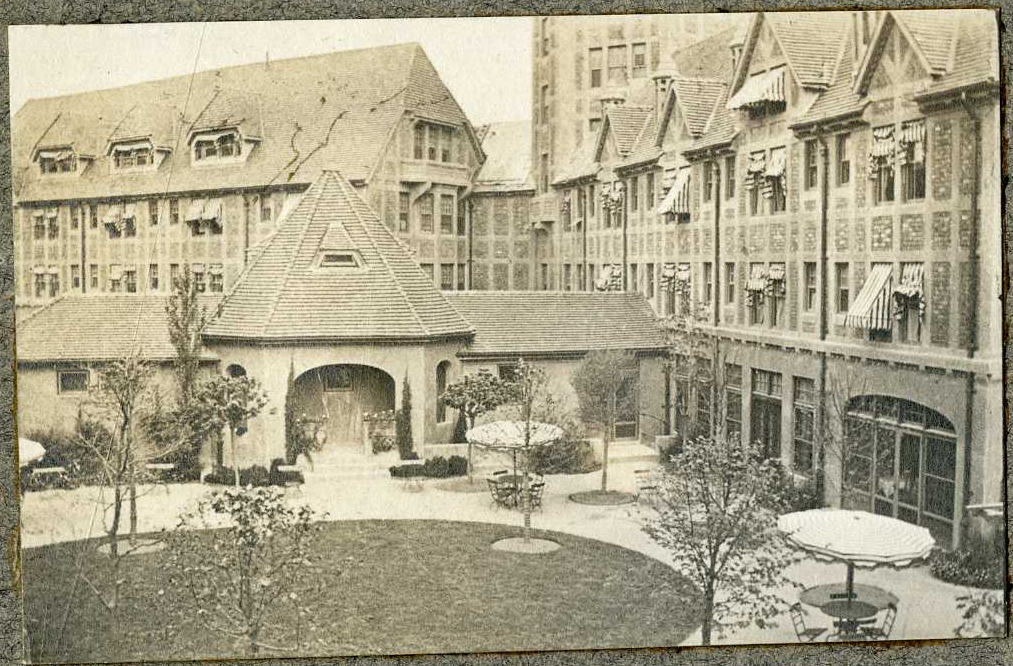
Tea Garden circa 1912. Photo courtesy of Olmsted Archives.
The July 12, 1924 edition of The Forest Hills Bulletin read, “The Tea Garden of the Forest Hills Inn is a veritable fairyland, when lighted with Japanese lanterns, with the trickling fountain heard in the background, and a new moon shining overhead. There is no more delightful place in Greater New York for one to spend the dinner hour.” Every evening during the warmer months between 6:30 and 9 PM, a delectable dinner was served, to the music of the Inn Trio, such as Dvorak’s “Humoresque,” Nevin’s “A Day in Venice,” Godard’s “Canzonetta,” and Albeniz’s “A Night In Seville.”
Fast-forwarding nearly 100 years, Alexandra Gecin of Forest Hills first noticed the serenity and relaxation upon stepping into the Tea Garden. She explained, “Imagining the weddings, celebrations and afternoon teas that took place many years ago, as well as a working central fountain, cascading fountain and turtle pond, and thriving plants that existed, only added to its ‘secret garden’ feel. The icing on the cake, and hopefully the start of a fruitful restoration, was Perlman’s replication of the Ring For Tea stand, with a Gardens blue-green paint and a bell from Ukraine.”
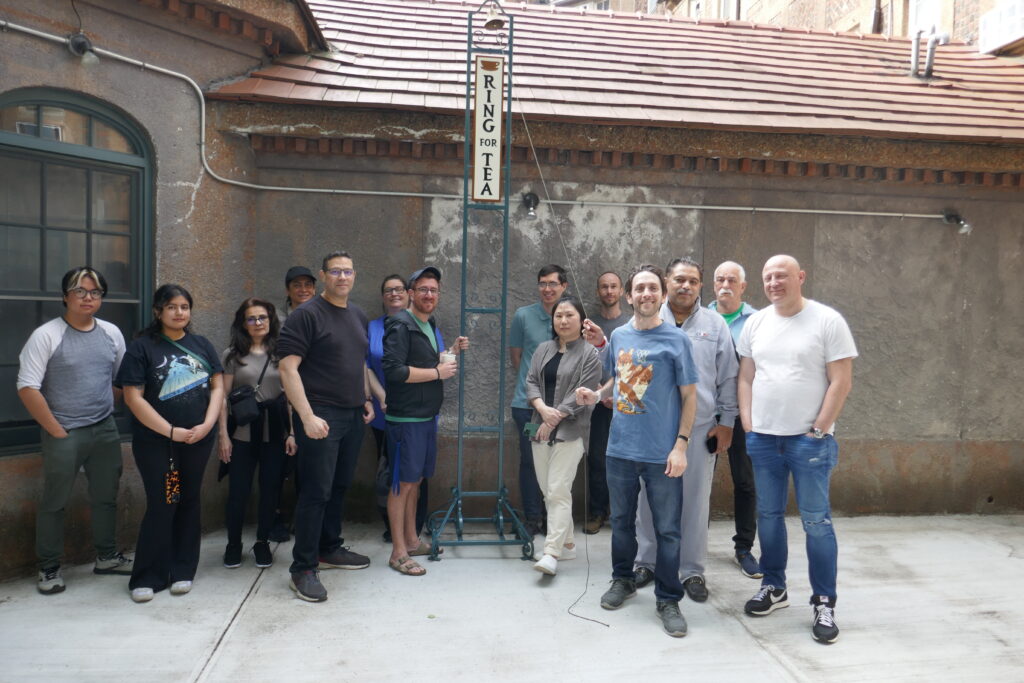
NY Tea Society & residents join Kumar at the replicated Ring For Tea stand. Photo courtesy of Jade staff
Gecin also had no idea that a tea society existed in Forest Hills, and considered it a “lovely surprise.” “The second surprise was that the head of the society actually planned a tea ceremony for us and we could chat about it,” she continued.
She shared her vision for the Tea Garden’s future. “In addition to celebrations in a restored Tea Garden, I envision a full British tea service, with finger sandwiches and pastries in the warmer months, and a hot chocolate/s’mores/fondue chalet-type experience in colder months. The fountain could become a fire pit in the winter to gather around. It would also be landscaped with shade-loving perennials and evergreens, to have even more of that garden feel year-round.”
Babylon resident Alexander Nguyen was unaware of how many people were interested in not only tea, but the whole culture and history surrounding tea. “As I grew up, I always thought that tea was just a drink for adults, usually in the morning and during dinner, since it was sweet, sugary, and full of color. Now that I have grown up and experienced the culture of the New York Tea Society, I learned that tea is often more than just a drink, but a centerpiece of social events between friends, and strangers alike, snacking on cookies, or talking about tea.”
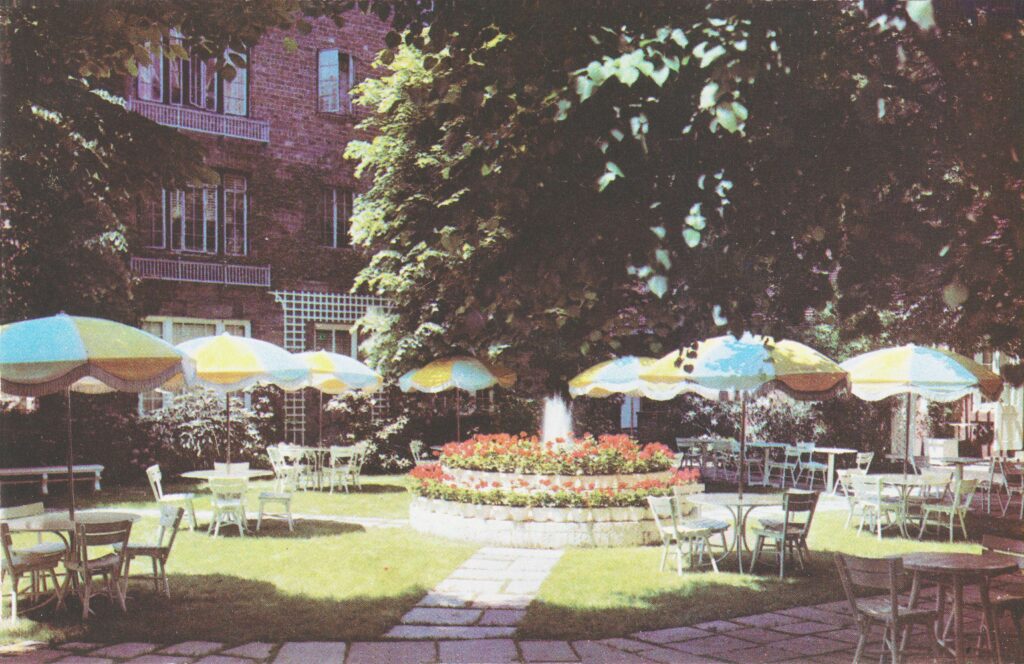
Tea Garden in 1950s with famed interior designer Dorothy Draper’s influence. Photo: Michael Perlman Postcard Collection
Nguyen stepped into this columnist’s exhibition at Jade’s gallery, which features restored vintage prints of the Tea Garden. “It made me wonder what events occurred in the garden, what kind of life it had, and what kind of stories could be told from its weathered walls and surface patina,” he said.
Nguyen felt that the Ring For Tea stand’s replication was a delight, adding to a surreal feeling of standing in a place of history upon viewing the vintage photos, which featured the original tea stand.
He explained his vision. “The Tea Garden could be restored to its prime, as a piece of serenity amidst a busy and bustling city. If the fountain were to be restored, then the garden would be like something out of a fairytale; a secluded sanctuary covered by trees and bushes, with the fountain at the center of it all.”
“The Tea Garden is beautiful, even in its semi-abandoned state, and hearing stories about its wedding receptions and the social and communal events at the Forest Hills Inn was very touching,” said Jamaica resident Aayesha Ayub, who found the area to be full of hope for a new life. “It was nice to see people from all walks of life and ages gather to experience a common love and interest. Having a space for the community to connect is my hope, and I would love to plant additional forestry to help create a more beautiful space that people can enjoy once again.”
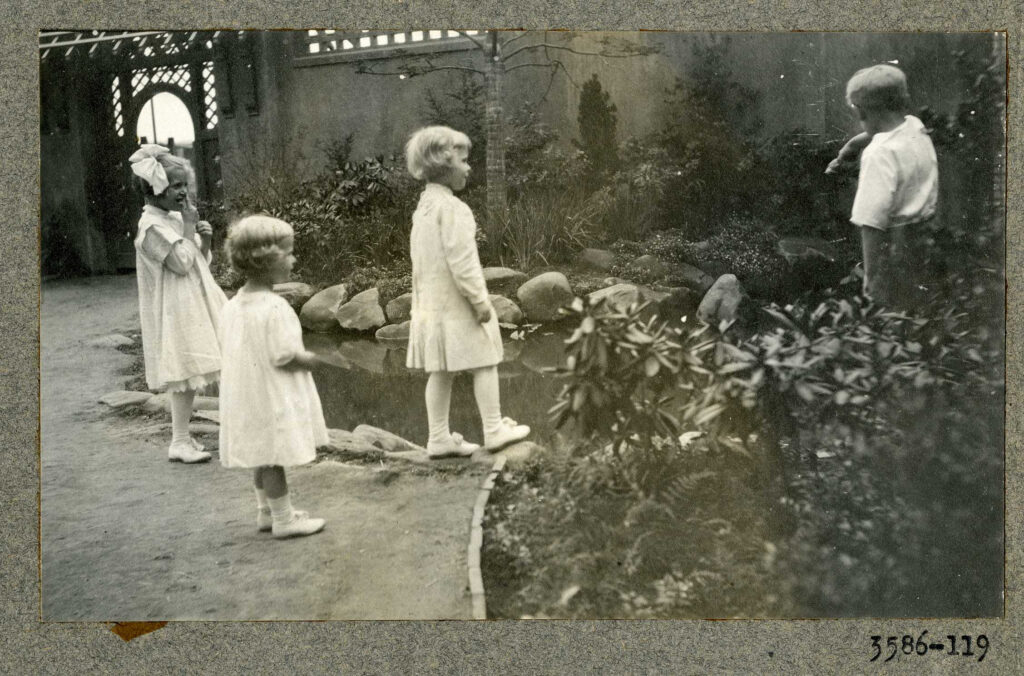
Children at the cascading fountain & turtle pond circa 1912. Photo courtesy of Olmsted Archives.
The peaceful and inviting Tea Garden and all it represents, is inspiring for its historical value for the community, according to Rosa M. Lazon of Forest Hills. “It could be the perfect space for community gatherings and cultural events, including tea ceremonies and educational artistic events,” she said.
Lazon described her experience as unique and educational, as the members of the tea society are very passionate about sharing their knowledge of tea ceremonies. “I want to express my great appreciation for what all supporters are doing to restore and preserve the Tea Garden,” she continued.
To support the Tea Garden initiative or volunteer, join the Facebook group. Additionally, to become an active member of the New York Tea Society and learn more, visit their page.



